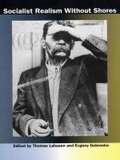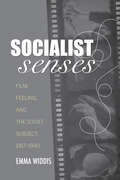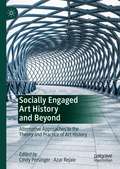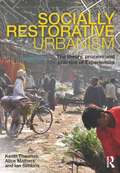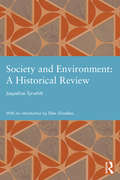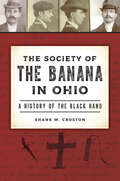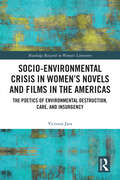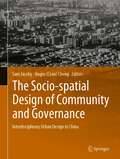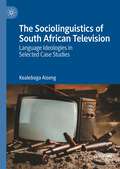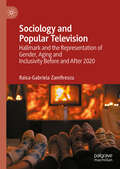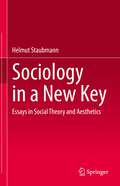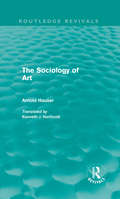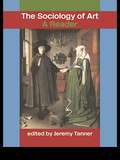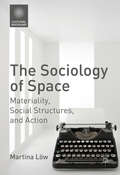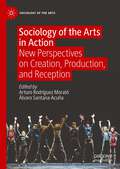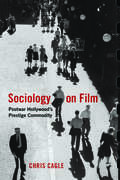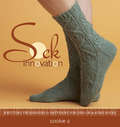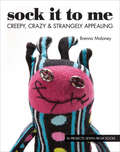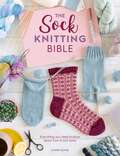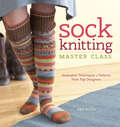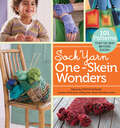- Table View
- List View
Socialist Realism without Shores
by Thomas Lahusen Evgeny DobrenkoSocialist Realism without Shores offers an international perspective on the aesthetics of socialist realism--an aesthetic that, contrary to expectations, survived the death of its originators and the demise of its original domain. This expanded edition of a special issue of the South Atlantic Quarterly brings together scholars from various parts of the globe to discuss socialist realism as it appears across genres in art, architecture, film, and literature and across geographic divides--from the "center," Russia, to various points at the "periphery"--China, Germany, France, Poland, remote republics of the former USSR, and the United States.The contributors here argue that socialist realism has never been a monolithic art form. Essays demonstrate, among other things, that its literature could accommodate psychoanalytic criticism; that its art and architecture could affect the aesthetic dictates of Moscow that made "Soviet" art paradoxically heterogeneous; and that its aesthetics could accommodate both high art and crafted kitsch. Socialist Realism without Shores also addresses the critical discourse provoked by socialist realism--Stalinist aesthetics, "anthropological" readings; ideology critique and censorship; and the sublimely ironic approaches adapted from sots art, the Soviet version of postmodernism.Contributors. Antoine Baudin, Svetlana Boym, Greg Castillo, Katerina Clark, Evgeny Dobrenko, Boris Groys, Hans Günther, Julia Hell, Leonid Heller, Mikhail Iampolski, Thomas Lahusen, Régine Robin, Yuri Slezkine, Lily Wiatrowski Phillips, Xudong Zhang, Sergei Zimovets
Socialist Senses: Film, Feeling, and the Soviet Subject, 1917–1940
by Emma Widdis&“Widdis&’s rich and fascinating book has opened a new perspective from which to think about the Soviet cinema.&” —Kritika This major reimagining of the history of Soviet film and its cultural impact explores the fundamental transformations in how film, through the senses, remade the Soviet self in the 1920s and 1930s. Following the Russian Revolution, there was a shared ambition for a &‘sensory revolution&’ to accompany political and social change: Soviet men and women were to be reborn into a revitalized relationship with the material world. Cinema was seen as a privileged site for the creation of this sensory revolution: Film could both discover the world anew, and model a way of inhabiting it. Drawing upon an extraordinary array of films, noted scholar Emma Widdis shows how Soviet cinema, as it evolved from the revolutionary avant-garde to Socialist Realism, gradually shifted its materialist agenda from emphasizing the external senses to instilling the appropriate internal senses (consciousness, emotions) in the new Soviet subject.
Socially Engaged Art History and Beyond: Alternative Approaches to the Theory and Practice of Art History
by Cindy Persinger Azar RejaieWhat is socially engaged art history? Art history is typically understood as a discipline in which academics produce scholarship for consumption by other academics. Today however, an increasing number of art historians are seeking to broaden their understanding of art historical praxis and look beyond the academy and towards socially engaged art history. This is the first book-length study to focus on these growing and significant trends. It presents various arguments for the social, pedagogical, and scholarly benefits of alternative, community-engaged, public-facing, applied, and socially engaged art history. The international line up of contributors includes academics, museum and gallery curators as well as arts workers. The first two sections of the book look at socially engaged art history from theoretical, pedagogical, and contextual perspectives. The concluding part offers a range of provocative case studies that highlight the varied and rigorous work that is being done in this area and provide a variety of inspiring models. Taken together the chapters in this book provide much-needed disciplinary recognition to socially engaged art history, while also serving as a springboard to further theoretical and practical work.
Socially Engaged Art in Contemporary China: Voices from Below (Routledge Research in Art and Politics)
by Meiqin WangThis book provides an in-depth and thematic analysis of socially engaged art in Mainland China, exploring its critical responses to and creative interventions in China’s top-down, pro-urban, and profit-oriented socioeconomic transformations. It focuses on the socially conscious practices of eight art professionals who assume the role of artist, critic, curator, educator, cultural entrepreneur, and social activist, among others, as they strive to expose the injustice and inequality many Chinese people have suffered, raise public awareness of pressing social and environmental problems, and invent new ways and infrastructures to support various underprivileged social groups.
Socially Restorative Urbanism: The theory, process and practice of Experiemics
by Kevin Thwaites Alice Mathers Ian SimkinsThe need for a human-orientated approach to urbanism is well understood, and yet all too often this dimension remains lacking in urban design. In this book the authors argue for and develop socially restorative urbanism – a new conceptual framework laying the foundations for innovative ways of thinking about the relationship between the urban spatial structure and social processes to re-introduce a more explicit people-centred element into urban place-making and its adaptation. Focusing on this interplay between humans and the built environment, two new concepts are developed: the transitional edge – a socio-spatial concept of the urban realm; and Experiemics – a participative process that acts to redress imbalances in territorial relationships, defined in terms of the awareness of mine, theirs, ours and yours (MTOY). In this way, Socially Restorative Urbanism shows how professional practice and community understanding can be brought together in a mutually interdependent and practical way. Its theoretical and practical principles are applicable across a wide range of contexts concerning human benefit through urban environmental change and experience, and it will be of interest to readers in the social sciences and environmental psychology, as well as the spatial planning and design disciplines.
The Société des Trois in the Nineteenth Century: The Translocal Artistic Union of Whistler, Fantin-Latour, and Legros (Routledge Research in Art History)
by Melissa BerryThis book reframes the formative years of three significant artists: Henri Fantin-Latour, Alphonse Legros, and James McNeill Whistler. The trio’s coming together as the Société des trois occurred during the emergence of the artistic avant-garde—a movement toward individualism and self-expression. Though their oeuvres appear dissimilar, it is imperative that the three artists’ early work and letters be viewed in light of the Société, as it informed many of their decisions in both London and Paris. Each artist actively cultivated a translocal presence, creating artistic networks that transcended national borders. Thus, this book will serve as a comprehensive resource on the development, production, implications, and eventual end of the Société.
Society and Environment: A Historical Review (Studies in International Planning History)
by Jaqueline TyrwhittJaqueline Tyrwhitt (1905-1983) was a British town planner, editor, and educator. This book includes four of Tyrwhitt’s key texts to illustrate how she forged and promoted a synthesis of Patrick Geddes’ bioregionalism and the utopian ideals of European Modernist urbanism, which influenced post-war academic discourse and professional practice in urban planning and design internationally. The key texts reprinted in this book are contributions from the Town and Country Planning Textbook (1950) which was published as an outcome for the Correspondence Course in Town Planning for members of the Allied Forces, which Tyrwhitt ran. It was designed to meet the requirements created by passage of the 1947 Town and Country Act and helped to shape a generation of planning practitioners in the UK and commonwealth countries.
The Society of the Banana in Ohio: A History of the Black Hand (True Crime)
by Shane W. CrostonA notorious case of terror and extortion in the Buckeye StateIn the early 1900s, a criminal society known as the Black Hand became feared across the United States as it extorted hard-working immigrants. In 1908, Agostino Iannarino received a series of threatening letters and when he refused to pay, a bomb exploded at the entrance of his Columbus home. His family fled to Sicily only to continue receiving threats. The following year, U.S. Post Office Inspectors learned that a Black Hand gang called the Society of the Banana was headquartered in Marion, Ohio, and authorities attempted to put an end to the violent outrages occurring across the Midwest.Revealing twenty-four extortion letters written by members of the Society of the Banana, author Shane W. Croston details factual and fatal accounts of the Black Hand.
A Society of Young Women: Opportunities of Place, Power, and Reform in Saudi Arabia
by Amélie Le RenardThe cities of Saudi Arabia are among the most gender segregated in the world. In recent years the Saudi government has felt increasing international pressure to offer greater roles for women in society. Implicit in these calls for reform, however, is an assumption that the only "real" society is male society. Little consideration has been given to the rapidly evolving activities within women's spaces. This book joins young urban women in their daily lives—in the workplace, on the female university campus, at the mall—to show how these women are transforming Saudi cities from within and creating their own urban, professional, consumerist lifestyles. As young Saudi women are emerging as an increasingly visible social group, they are shaping new social norms. Their shared urban spaces offer women the opportunity to shed certain constraints and imagine themselves in new roles. But to feel included in this peer group, women must adhere to new constraints: to be sophisticated, fashionable, feminine, and modern. The position of "other" women—poor, rural, or non-Saudi women—is increasingly marginalized. While young urban women may embody the image of a "reformed" Saudi nation, the reform project ultimately remains incomplete, drawing new hierarchies and lines of exclusion among women.
Socio-Environmental Crisis in Women’s Novels and Films in The Americas: The Poetics of Environmental Destruction, Care, and Insurgency (Routledge Research in Women's Literature)
by null Victoria JaraThe climate crisis has reached a critical point, necessitating urgent global action. Women’s activism against environmental dispossession in the Americas manifests not only in protests and classrooms but also through artistic filmmaking and writing. This book focuses on the overlooked contributions of women filmmakers and novelists, highlighting how their work reveals the connections between environmental dispossession and various injustices related to gender, ethnicity, age, class, and labor. It demonstrates that contemporary women in the Americas engage deeply with ecological issues, analyzing their representations and identifying common principles across texts. Using an interdisciplinary approach from environmental humanities, gender and Indigenous studies, and film and literary studies, the author compares works from Canada and Latin America. Three poetics emerge: environmental destruction critiques harmful development; care expands notions of reciprocity beyond the human; and insurgency showcases struggles against extractivist models. These works invite readers to understand the complex interconnections of environmental justice within society.
The Socio-spatial Design of Community and Governance: Interdisciplinary Urban Design in China
by Sam Jacoby Jingru Cyan ChengThis book proposes a new interdisciplinary understanding of urban design in China based on a study of the transformative effects of socio-spatial design and planning on communities and their governance. This is framed by an examination of the social projects, spaces, and realities that have shaped three contexts critical to the understanding of urban design problems in China: the histories of “collective forms” and “collective spaces”, such as that of the urban danwei (work-unit), which inform current community building and planning; socio-spatial changes in urban and rural development; and disparate practices of “spatialised governmentality”. These contexts and an attendant transformation from planning to design and from government to governance, define the current urban design challenges found in the dominant urban xiaoqu (small district) and shequ (community) development model. Examining the histories, transformations, and practices that have shaped socio-spatial epistemologies and experiences in China – including a specific sense of community and place that is rather based on a concrete “collective” than abstract “public” space and underpinned by socialised governance – this book brings together a diverse range of observations, thoughts, analyses, and projects by urban researchers and practitioners. Thereby discussing emerging interdisciplinary urban design practices in China, this book offers a valuable resource for all academics, practitioners, and stakeholders with an interest in socio-spatial design and development.
The Sociolinguistics of South African Television: Language Ideologies in Selected Case Studies
by Kealeboga AisengThis book explores the interwoven relationship between language, media, and society in post-Apartheid South Africa. The author examines selected case studies from the sociolinguistic landscape of South African television, analysing dominant language ideologies and illuminating the challenges, opportunities, and potential for transformation. He argues for the power of television in shaping language ideologies, fostering cultural understanding, and advocating for more inclusive and equitable language usage in the media. This book contributes to the field of sociolinguistics by emphasizing the complexity of multilingualism in South Africa and inviting ongoing exploration and dialogue in this landscape. It will be of interest to students and scholars of Sociolinguistics, Media Studies, African Culture and History, and Language Policy and Planning.
Sociology and Architectural Design (Social Science Frontiers)
by John ZeiselThis book, encouraging more effective collaboration between professional architects and social scientists, outlines how social science research can aid the design process, detailing how physical environment relates to behavior. With a foreword by Hugh F. Cline.
Sociology and Popular Television: Hallmark and the Representation of Gender, Aging and Inclusivity Before and After 2020
by Raisa-Gabriela ZamfirescuThis book examines representations of gender, age and identity across the Hallmark film and television output in relation to specific periods of time that pertain to changes within the specific entertainment sector. Using a comprehensive collection of 628 original Hallmark television films released between January 2015 and December 2023, the book applies content analysis to a variety of quantitative, qualitative, and mixed data, including behind-the-scenes credits, actors and actresses, characters and their narratives, promotional posters, Facebook comments, and official synopsis. In addition to examining diversity of race and religion, it analyses ageism through the portrayal of elders and young people in idealized imagery and stereotypes, inclusivity of LGBTQ and disabled characters, and ageism in relation to both masculinities and femininities. This book will be of interest to readers in fields including gender studies and sociology, visual communication, film and television studies, aging, media and communications, and popular culture.
Sociology in a New Key: Essays in Social Theory and Aesthetics
by Helmut StaubmannThis book presents essays that address fundamental issues in social and cultural theory by viewing them through the lens of aesthetic theory. Drawing on the aesthetic theories of Theodor W. Adorno, Gregory Bateson, Jean-Marie Guyau, Talcott Parsons and Georg Simmel, it suggests a new take on basic sociological concepts and methodologies. The chapters cover a wide range of topics, including the sensuality of social action, social construction of unreality, and The Rolling Stones’ enduring success as a reflection of our society and culture. The book’s title Sociology in a New Key refers to a classic work by Susanne K. Langer, whose Philosophy in a New Key argued for a reorientation of modern philosophical thought based on a thorough account of symbolism in general and of the arts in particular. In this way, the basic ideas and assumptions of the philosophical tradition are transposed to new understandings and perspectives. After all, it was Georg Simmel himself who claimed to have gained several of his general theoretical insights “via the detour of reflections on the essence of art.” The book will appeal to scholars and students of the sociology of the arts and music, and to anyone interested in the intersection of social theory and aesthetics.
The Sociology of Art (Routledge Revivals)
by Arnold HauserFirst published in 1982, The Sociology of Art considers all forms of the arts, whether visual arts, literature, film, theatre or music from Bach to the Beatles. The last book to be completed by Arnold Hauser before his death in 1978, it is a total analysis of the spiritual forces of social expression, based upon comprehensive historical experience and documentation. Hauser explores art through the earliest times to the modern era, with fascinating analyses of the mass media and current manifestations of human creativity. An extension and completion of his earlier work, The Social History of Art, this volume represents a summing up of his thought and forms a fitting climax to his life’s work. Translated by Kenneth J. Northcote.
Sociology of Art: A Reader
by Jeremy TannerIntroducing the fundamental theories and debates in the sociology of art, this broad ranging book, the only edited reader of the sociology of art available, uses extracts from the core foundational and most influential contemporary writers in the field. As such it is essential reading both for students of the sociology of art, and of art history. Divided into five sections, it explores the following key themes: * classical sociological theory and the sociology of art * the social production of art * the sociology of the artist * museums and the social construction of high culture* sociology aesthetic form and the specificity of art. With the addition of an introductory essay that contextualizes the readings within the traditions of sociology and art history, and draws fascinating parallels between the origins and development of these two disciplines, this book opens up a productive interdisciplinary dialogue between sociology and art history as well as providing a fascinating introduction to the subject.
The Sociology of Space: Materiality, Social Structures, and Action (Cultural Sociology)
by Martina LöwIn this book, the author develops a relational concept of space that encompasses social structure, the material world of objects and bodies, and the symbolic dimension of the social world. Löw’s guiding principle is the assumption that space emerges in the interplay between objects, structures and actions. Based on a critical discussion of classic theories of space, Löw develops a new dynamic theory of space that accounts for the relational context in which space is constituted. This innovative view on the interdependency of material, social, and symbolic dimensions of space also permits a new perspective on architecture and urban development.
Sociology of the Arts in Action: New Perspectives on Creation, Production, and Reception (Sociology of the Arts)
by Arturo Rodríguez Morató Alvaro Santana-AcuñaThis edited collection carries out an extensive coverage of the sociology of arts’ most characteristic thematic areas (production, creation, the artwork, and reception) across an important range of artistic fields, from the most traditional to the more unusual. It makes an argument for the theoretical creativity and empirical expansion that characterizes the study of contemporary sociology of the arts. Such creativity is present in the increasingly predominant approach to a sociology of the arts in action, in all areas of inquiry within the discipline. The range of theoretical paradigms evoked is rich, analysing several of the most important theoretical frameworks currently handled in the discipline (Bourdieu, Becker, Peterson, ANT), and combining them with the works of many other influential contemporary specialists (De Nora, Hennion, Lamont, Menger and Born et al.). The book also establishes links to less known theoretical frameworks and some from different fields including economic sociology,microsociology, ethnomethodology, semiotics, and cultural history. The volume argues that Spanish-speaking scholars are now at the forefront of new developments in the field of the sociology of the arts, and is the first effort to gather research by these influential Spanish-language scholars in a single volume for an English-language audience.
Sociology on Film: Postwar Hollywood's Prestige Commodity
by Professor Chris CagleAfter World War II, Hollywood’s “social problem films”—tackling topical issues that included racism, crime, mental illness, and drug abuse—were hits with critics and general moviegoers alike. In an era of film famed for its reliance on pop psychology, these movies were a form of popular sociology, bringing the academic discipline’s concerns to a much broader audience. Sociology on Film examines how the postwar “problem film” translated contemporary policy debates and intellectual discussions into cinematic form in order to become one of the preeminent genres of prestige drama. Chris Cagle chronicles how these movies were often politically fractious, the work of progressive directors and screenwriters who drew scrutiny from the House Un-American Activities Committee. Yet he also proposes that the genre helped to construct an abstract discourse of “society” that served to unify a middlebrow American audience. As he considers the many forms of print media that served to inspire social problem films, including journalism, realist novels, and sociological texts, Cagle also explores their distinctive cinematic aesthetics. Through a close analysis of films like Gentleman’s Agreement, The Lost Weekend, and Intruder in the Dust, he presents a compelling case that the visual style of these films was intimately connected to their more expressly political and sociological aspirations. Sociology on Film demonstrates how the social problem picture both shaped and reflected the middle-class viewer’s national self-image, making a lasting impact on Hollywood’s aesthetic direction.
Sock Innovation: Knitting Techniques and Patterns for One-of-a-kind Socks
by Cookie ApichairukUnconventional, rule-breaking socks are part and parcel in this unique guide to sock knitting that includes 15 new sock patterns. The skills of the average sock knitter are increased through design exploration and advanced stitch manipulation, treating the sock as a knitted canvas where elements are strategically and intentionally placed. New designs of floral lace patterns, angular geometric shapes, and unusual cables are presented along with detailed instructions on modifications to suit needs and aesthetics. The incredible range of style and complexity in this guide runs from sweet and simple to delightfully imaginative.
Sock It to Me: Creepy, Crazy & Strangely Appealing
by Brenna MaloneyAn easy method to faster quilt-making, and incredible patterns to make use of your scrap stash. What if you could piece quilts even faster, work on more than one quilt simultaneously and save money, fabric and thread all at the same time? Bonnie K. Hunter will show you how to put the concept of Leaders & Enders to work quickly and easily, expanding your creativity, and upping your productivity all at the same time. If you have ever found yourself paralyzed by your stash, overwhelmed by scraps you just can't bear to toss out, arm yourself with a new rotary blade for your cutter, make yourself a cup of tea and start reading. This book is not only full of beautiful scrap quilts that can be made in between the lines of other sewing, but also contains many ideas for getting your ever burgeoning scrap stash under control, into useable sized pieces that work well with one another, and ready to be sewn into quilts you've always wanted to make. Bonnie K. Hunter has done it again!
The Sock Knitting Bible: Everything you need to know about how to knit socks
by Lynne RoweThe definitive guide to knitting cozy, colorful socks, covering every aspect for knitters of all abilities.The Sock Knitting Bible is the ultimate reference for sock knitting skills, techniques, materials, projects, and more. Here you'll find in-depth information on everything from sizing and yarn to casting on and color-work. Whether you want to knit toe up, cuff down or even two at a time socks, this comprehensive volume covers it all.There are step-by-step instructions for all the various sock knitting techniques, as well as three basic sock patterns that even an absolute beginner can follow. Author Lynne Rowe also looks at the different kinds of tools available, from double pointed needles and small circular needles to innovative products such as flexible DPNs.And it all comes together with ten delightful projects by some of the most exciting and talented sock designers. Here you will find patterns for stripes, fair isle, cables, lacy, sparkly and snuggly socks: an array o pattern for all your sock-knitting needs!
Sock Knitting Master Class: Innovative Techniques + Patterns from Top Designers
by Ann BuddWork from the ground up with knitwear design: create your own socks!Sock Knitting Master Class showcases methods for designing and knitting creative socks, featuring signature elements and techniques from 16 top designers. You'll learn what makes good sock design, and then dive into knitting 18 spectacular, brand-new patterns featuring the widest variety of techniques.With patterns divided into two sections by top-down and toe-up construction, Sock Knitting Master Class explores such techniques as cables, twisted stitches, lace, stranded colorwork, entrelac, shadow knitting, and intarsia worked in the round. Plus, you'll discover inventive ways to start and end socks, shape heels and toes, and knit the soles. Sock Knitting Master Class is an all-star assembly of the most inventive, exciting designers working in socks including Cookie A, Kathryn Alexander, Nancy Bush, Cat Bordhi, Priscilla Gibson-Roberts, Anne Hanson, Melissa Morgan-Oakes, Meg Swanson, Anna Zilboorg, and many more. And you'll also learn how each yarn contributes to the overall design from Clara Parkes.
Sock Yarn One-Skein Wonders®: 101 Patterns That Go Way Beyond Socks! (One-Skein Wonders)
by Judith DurantSock yarn isn’t just for socks anymore! Veteran knitter Judith Durant presents 101 original projects that can be created from just a single skein of sock yarn, including adorable baby clothes, warm hats, beautiful scarves, and even a dog sweater. A quick and creative way to use up leftovers, many of these projects knit up in less than three hours. Adapted from designs contributed by yarn shops and crafters from throughout North America, knitters of all types will delight in these fun and stylish creations.
